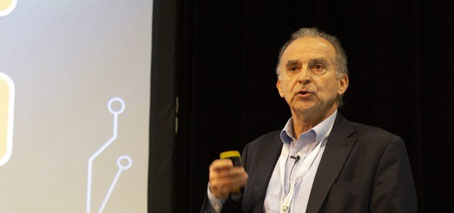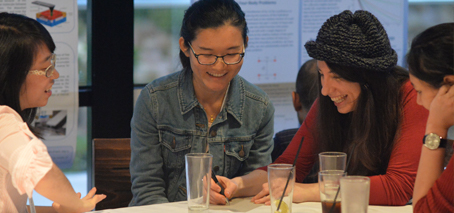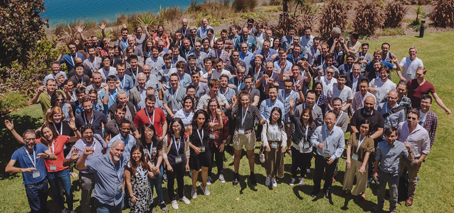Using Multidimensional Coherent Spectroscopy (MDCS), we have revealed quantum superpositions among low energy states in an optimally doped cuprate superconductor that remain coherent for more than 500fs. This observation points to a strong correlation between the low energy modes (e.g. phonons, magnons, charge density waves, or many body electron states, etc) and the optically excited states. These correlations are mediated …
Unconscious Bias Unplugged
Designed to debunk the myths around unconscious bias and to help you better understand what can be done in a workplace to ensure that biases (conscious or unconscious) are neutralised. This session discusses: 1.Diversity and inclusion 2.What unconscious bias is 3.How humans process information 4.Ways to identify areas of unconscious bias 5.Micro aggressions 6.Some of the impacts of unconscious bias …
Materials Research in the Electronics Industry
The electronics industry has led the development of new materials to support the scaling of silicon device technology to meet the ever-demanding Moore’s law [i] over the last 70 years. Silicon dioxide is a prime example of such scaling from a thickness of several hundred nanometers to about 2 nm at the end of the 1990’s. At that time nitrogen …
Precision measurements of elementary excitations in a unitary Fermi gas
The study of many-body quantum systems with strong inter-particle interactions is of great interest for the understanding of novel materials. Ultracold atomic gases allow the precise tuning of interactions between atoms via a Feshbach resonance. We experimentally realise such gases with fermionic atoms at unitarity exhibiting the strongest interactions allowed by quantum mechanics. Using two-photon Bragg spectroscopy, we study the …
Synthesis and Atomic-Scale Characterization of Superconducting van-der-Waals Heterostructures
The emergence of atomically thin materials post graphene, has opened up new avenues for the engineering of electronic states via van-der-Waals heterostructures. For instance, tunable large bandgap 2D topological insulators, such as quantum spin Hall (QSH) insulators, have recently shown promise for device applications above 100K. On the other extreme of temperature, van-der-Waals heterostructures of QSH insulators can offer a …
Staying Well in Academia
Working in academia is both an exciting and challenging experience. It can be an emotional roller-coaster. The excitement of working on something you care about, sharing ideas with students and colleagues and making a contribution to knowledge. The challenges of feeling isolated and overwhelmed, dealing with setbacks, uncertainty, conflict and loss of motivation. Inevitably over the course of your career …
Three-dimensional electron-hole superfluidity in a superlattice close to room temperature
Prof. David Neilson, University of Antwerp Although there is strong theoretical and experimental evidence for electron-hole superfluidity in separated sheets of electrons and holes at low T, extending superfluidity to high T is limited by strong 2D fluctuations and Berezinskii-Kosterlitz-Thouless topological effects. We show this limitation can be overcome using a superlattice of alternating electron-doped and hole-doped semiconductor monolayers. The superfluid transition in a …
Quantum transport properties at high magnetic fields and pressure-induced superconductivity in layered PtBi2
Triply degenerate point (TP) fermions in tungsten-carbide-type materials (e.g., MoP), which represent new topological states of quantum matter, have generated immense interest recently. However, the TPs in these materials are found to be far below the Fermi level, leading to the TP fermions having less contribution to low-energy quasiparticle excitations. Here, we theoretically predict the existence of TP fermions with …
The MacDiarmid Difference: Culture change and impact in a New Zealand Centre of Research Excellence
The MacDiarmid Institute was founded in 2002, with a vision of economic transformation through excellence and capability development in materials science, and with a broad mandate to work beyond the lab bench. 17 years on, this talk will focus on some of the ways in which the Institute is leading culture change; from entrepreneurship leading to 17 spinout companies, to …
Some theoretical results for twisted bilayer graphene near magic angle
When the relative rotation between two sheets of graphene is set to be close to special angles (referred to in the literature as “magic angles”), the low-energy effective theory features Dirac fermions with very flat bands. Interest in understanding the competing mechanisms at play was reignited recently with the experimental observations of superconductivity and strongly correlated insulating phases in such …
Tuning the Edge States of Topological Crystalline Insulator Bismuthene via Substrate Effects
Chutian Wang, Monash University One of the key challenges in design of devices bases on topological materials is to conveniently turn the surface and edge states on and off. Two-dimensional (2D) topological crystalline insulators (TCI) are ideal materials for achieving this switch, as their edge states can be turned on/off by applying a symmetry-breaking field. However, it remains unresolved how …
Dynamics of impurities in quantum gases
The quantum impurity problem is relevant to a range of different systems in physics, and it continues to be a highly active area of research. In ultracold atomic gases, the impurity problem can be realised by introducing a small number of atoms of a different species into a background gas. The interaction between the impurity and the background medium can …
Dynamic Conductivity of nanoscale bubble domains in ferroelectric thin films
About the speaker Vivasha Govinden is a PhD student working with Prof Nagy Valanoor at UNSW to investigate ferroelectric coupling with the introduction of a spacer between ferroelectric thin films, leading to exotic ferroelectric domains that can contribute to a giant electromechanical response. An enhanced electromechanical response is key to applications in nanoelectronic sensors, memory and logic devices and electromechanical …
Antisymmetric magnetoresistance in van der Waals Fe3GeTe2/graphite/Fe3GeTe2 trilayer heterostructures
With no requirements for lattice matching, van der Waals (vdW) ferromagnetic materials are rapidly establishing themselves as effective building blocks for next-generation spintronic devices. We report a hitherto rarely seen antisymmetric magnetoresistance (MR) effect in vdW heterostructured Fe3GeTe2 (FGT)/graphite/FGT devices. Unlike conventional giant MR (GMR), which is characterized by two resistance states, the MR in these vdW heterostructures features distinct high-, …
Deterministic Switching of Ferroelectric Bubble Nanodomains
Qi Zhang1, Sergei Prokhorenko2, Yousra Nahas2, Lin Xie3, Laurent Bellaiche2, Alexei Gruverman4 and Nagarajan Valanoor1 1School of Materials Science and Engineering, The University of New South Wales, Sydney, New South Wales 2052, Australia; 2 Physics Department and Institute for Nanoscience and Engineering, University of Arkansas, Fayetteville, AR 72701, USA; 3Department of Physics, Southern University of Science and Technology, Shenzhen, 518055 …
A room-temperature ferroelectric semimetal
Coexistence of reversible polar distortions and metallicity leading to a ferroelectric metal, first suggested by Anderson and Blount in 1965, has so far remained elusive. Electrically switchable intrinsic electric polarization, together with the direct observation of ferroelectric domains, has not yet been realized in a bulk crystalline metal, although incomplete screening by mobile conduction charges should, in principle, be possible. …
Resonant photovoltaic effect in doped magnetic semiconductors
The rectified non-linear response of a clean undoped semiconductor to an ac electric field includes a well known intrinsic contribution — the shift current. We show that when Kramers degeneracy is broken, a distinct second-order rectified response appears that is due to Bloch state anomalous velocities in a system with an oscillating Fermi surface. This effect, which we refer to …
Quantitative acoustic models for superfluid circuits
One of the goals of FLEET is to develop transistor technology using superfluid circuits. In collaboration with the ARC Centre of Excellence for Engineered Quantum Systems, we experimentally realize a highly-tunable superfluid oscillator circuit in a quantum gas of ultracold atoms, and develop and verify a simple lumped-element description of this circuit. At low oscillator currents, we demonstrate that …
The non-equilibrium Green’s function approach, an emerging simulation technique for novel devices
We use non-equilibrium Green’s functions, tight-binding and effective models to understand transport in a range of nanoscale devices. In 2019, this has included developing a new tight-binding model for low-dimensional allotropes of Bismuth (with the Monash node), studying the effects of spin-orbit coupling in two-dimensional electron gases (with the UNSW node), and Majorana fermions in nanowires. In addition, we have …
Phase diagram in 2DEG with Spin orbit coupling
I study the phase diagram of two dimensional electron systems with Rashba and Dresselhaus spin orbit coupling systems. And we find there are two Fermi Liquid phase which have no spin polarisation. In addition, there is also a in plane spin polarisation phase. We also find a out-of-plane spin polarisation phase by Monte-Carlo simulation, which we are still study on …
Towards a 2D Organic Topological Insulator
In this talk I will discuss the steps we have taken so far in pursuing the goal of synthesising a 2D organic topological insulator comprised of 9,10-dicyanoanthracene (DCA) as the organic species. In particular, I will discuss our recently published results regarding a formation of a sub-monolayer of DCA molecules on Ag(111) where the individual molecular species exhibit charging when …
Motion and teleportation of bubble skyrmions in low-dimensional ferroelectrics
Polar bubble domains are complex topological defects akin to magnetic skyrmions that can spontaneously form in ferroelectric thin films and superlattices. They can be deterministically written and deleted and exhibit a set of properties, such as sub-10 nm radius and room- temperature stability, that are highly attractive for dense data storage and recongurable nano-electronics technologies. However, possibilities of controlled motion …
Learning to tell their science story: ECR comms training
Communications workshop for early-career researchers and PhD students Success in science requires the ability to describe one’s research in a coherent and compelling manner. FLEET has made an early start in building these skills in ECRs, with a half-day training session targeting science communications skills. A professional external facilitator from consultancy Mind Your Way coached young researchers on the particular …
FLEET’s first annual workshop: member engagement
Forging a Centre that is greater than the sum of its parts FLEET’s inaugural annual workshop in Torquay, Victoria, represented the Centre’s first chance to cement relationships between geographically-isolated research nodes and diverse physics disciplines. With a focus on education, each day began with a tutorial laying out the fundamentals for one of three research themes. This introduction maximised the …
Building a cohesive Centre: 2018 annual workshop
Forging a Centre that is greater than the sum of its parts FLEET’s second annual workshop built on the successes of the 2017 workshop, bringing all of the Centre’s members and many international partners together in Magenta, mid-coast New South Wales. As in 2017, the workshop was family friendly, with partners and family made welcome at shared meals, social events …




